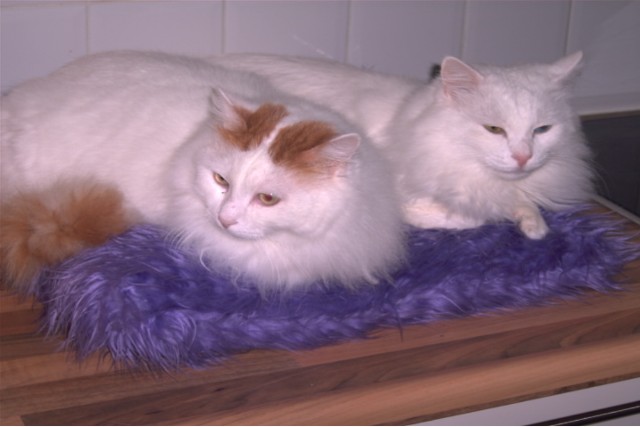Anerkennung von TICA und WCF von
Articles written by Sharon and Melvin Walcott - cattery Aledo, US (2006)
WEISSE TüRKISCH VAN Katzen
The all-white Turkish Van WCG � Dortmund, 30 March 2007
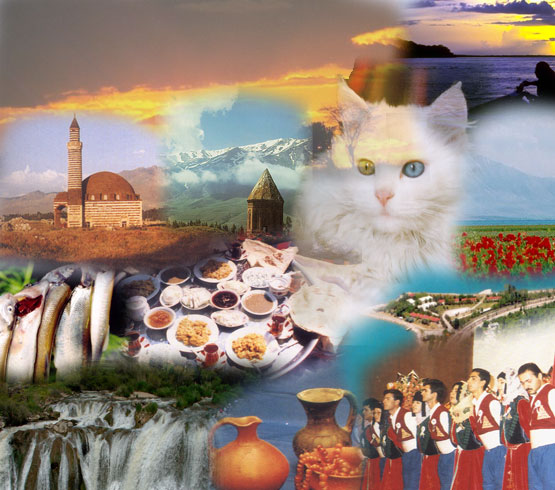
The all-white Turkish Van
World Cat Congres � Dortmund
March 30, 2007
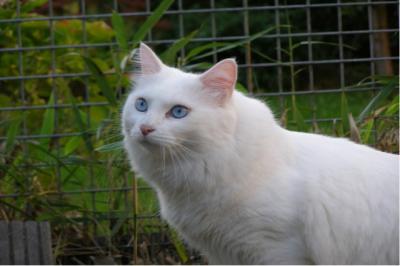
Leonardo-Van von Glasbach
All-white blue-eyed Turkish Van male
Picture/owner: Anke & Ger Baks
Since 1992, European and US breeders have been working to get the white Turkish Van accepted for championship. Not because they were �bored� of the colors that were already accepted and they simply wanted something �new�, but because pure white is actually the original color of the Turkish Van cat in Turkey �
1. Historical Background
Van patterned Turkish Vans
In Europe and the United States the Turkish Van is mostly known as a semi-longhaired cat with a unique pattern: colored markings restricted primarily to the head and tail (piebald-gene). They were first brought to Europe (the UK) in 1955, by two British photographers called Sonja Halliday and Laura Lushington. When working in Turkey, they were given a male and female kitten. Fascinated by these unusual cats, they took them back with them to Britian.
After the inevitable long period of quarantine, the two animals arrived at Laura Lushington�s home, where it soon became clear that they belonged to an exceptionally attractive breed which was new to the world of pedigree cats. In order to start a serious breeding program with them, they collected five more examples on subsequent trips to Eastern Turkey. Then began the procedure of establishing them as an officially recognized new breed. It took 14 years and the breed was at last given recognition in 1969. The Turkish Van Cat was late appearing in the United States, the first specimens not arriving there until 1982.
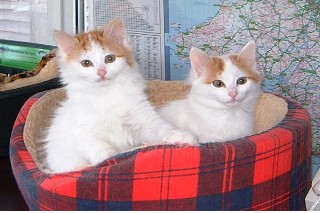
Patterned Turkish Van kittens. Picture: Suzann Lloyd, UK
1.2 All white Turkish Vans (in Turkish: Van Kedisi)
Anyway, by having these cats, with colored markings on head and tail, recognised as Turkish Vans, a problem arose. A curious discovery about the true coloring of the Van Cat was made by feline expert Roger Tabor, during location filming for his 1991 television series �The Rise of the Cat�. He visited Lake Van and discussed the breed with local people in Turkey, only to find that they considered a true Van Cat to be an all-white animal, without any markings on head and tail. There were cats present with auburn markings that are so well known in the West, but they were considered to be inferior to the all-white ones.
In Turkey the all-white Turkish Van is known as �Van Kedisi�, meaning Cat from Van. The most sought after is an odd eyed white cat, but blue eyed cats are also seen as special; the amber eyed white cat is the least sought after. In the mid-1990s the ��Van Cat House��, a Van Cat breeding and research center, was established within the campus of Van University (Van Yuzuncu Yil University). An enormous statue of an all-white Turkish Van Cat and kitten stands at the entrance of the city of Van.
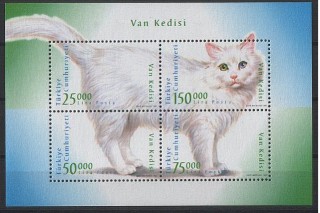
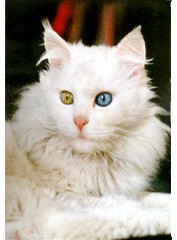
Odd-eyed all-white
The all-white Turkish Van, or �Van Kedisi� pictured on Turkish Stamps Turkish Van
1.3 Modern Western ways falling into line with ancient Eastern traditions
All of this came as no surprise to Turkish Van Cat breeder Lois Miles (�2005) who had been given the same information when she had contacted the Turkish Cultural Attach� in Van (Turkey) to ascertain the true status of the breed in its city of origin. Lois Miles wanted a genuine Turkish Van Cat from Van and despite of the difficulties it might cause with Western show judges, to be correct it would have to be an all-white odd-eyed cat. Lois Miles succeeded in obtaining written permission from the Turkish authorities to bring home a white, odd-eyed female. With help of her friends and a Turkish Professor, she brought an all-white kitten called Layla to the UK.
Like Roger Tabor, Lois Miles found that the local Turks preferred the all-white Van Cat. She felt it was purely accidental that the original pair brought back to England in 1955 happened to have auburn markings on the head and tail.
With the advent of Layla, the situation changed, as modern Western ways finally fell into line with ancient Eastern traditions. Since her arrival in the UK, Layla produced many kittens. Among her progeny, there have been several of the �Turkish Ideal�� (all-white) as well as cats with colored markings on the head and tail.
Tansdale Golden Girl & Yakamoz Sultan Ahmet
Van-patterned Turkish Van and all-white Turkish Van
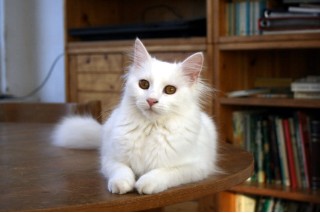
Haziran Fahriye van Yakamoz, all-white amber eyed Turkish Van female. Owner: J. Ouderkerk
2. Recognition of the all white Turkish Van
More cats were imported from Turkey to Europe to be used for the breeding of the all-white Turkish Van. They were bred to Van patterned Turkish Vans and all-white male and female offspring was sold to the UK and to the United States, where they had also learned about this original color of the Turkish Van.
Today, approximately 75 all-white Turkish Vans are registered in different organisations worldwide and all-white Turkish Vans can now be found in almost every Turkish Van pedigree. About 15 to 20 registered breeders are using all-white Turkish Vans for their breeding program.
GCCF
On February 23rd, 2005, the Gouverning Council of the Cat Fancy (GCCF, UK) granted Preliminary recognition for the all white Turkish Van (Turkish Vankedisi) with immediate effect. The cats can be shown in the Semi-longhair section at GCCF licenced shows in Assessment classes.
LOOF
In 2004, The French Gouverning Council of Cat Fancy, the LOOF, approved the addition of the all white Turkish Van (le blanc uni est accept�) to the Turkish Van standard.
2.3 TICA
O n September 1st, 2006, the TICA Board Of Directors met in Hannover (Germany) and approved the addition of the all white Turkish Van cat (Vankedisi) to the Turkish Van Standard. This change made the white Turkish Van eligible for registration and championship competition alongside the patterned Turkish Van effective May, 1st, 2007. TICA is the world�s largest genetic cat registry with cats shown and registered worldwide. The effort to include the all white Turkish Van was organized by members of the TICA Turkish Van Breed section with support from members on three continents and in five countries with a lot of support and help from many Turkish nationals. It is hoped that this change will help the white Turkish cats to be considered as one of the treasures of Turkey that should be preserved and appreciated throughout the world.
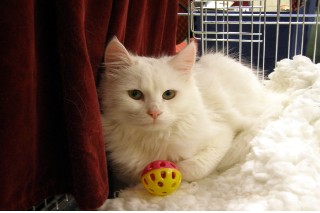
�zg�r�s R�stem Paga,
All white Turkish Van. Owner: M. Schacht
2.4 WCF
On March 31st, 2007, at the WCC-show in Dortmund (Germany), 15 specimens of the all white Turkish Van will be presented to the judges. Hopefully this will result in the WCF�s decision to also make the white Turkish Van eligible for registration and championship competition alongside the patterned Turkish Van in the World Cat Federation (WCF).
3. Breeding with the all-white Turkish Van
As said before, over the years, more pure white semi-longhaired cats from Turkey were brought to Europe to be used for the all-white Turkish Van breeding program.
3.1 All-white Turkish Van vs Turkish Angora
Some breeders, who were and are against the recognition of the all-white Turkish Van for several reasons, accused Turkish Van breeders of using white Turkish Angora�s to breed all-white Turkish Vans. This is definitely not true. For the breeding of all-white Turkish Vans, white Turkish Vans were brought to Europe directly from Turkey. Some breeders say that one simply can not tell the difference between an all-white Turkish Van and a Turkish Angora. Well�. when you lay the standard of a Turkish Van next to the standard of a Turkish Angora, the description of those cats is definitely not the same. The Turkish Angora is far more elegant, the size of the ears and the earsetting are different, the shape of the eyes is different, etc. Ofcourse, some all-white Turkish Vans will look like Turkish Angora�s and vice versa, but in that case, either one of them wasn�t bred according to the standard which does not mean they suddenly belong to a different breed. It�s all in the pedigree.
~ No difference in type? ~
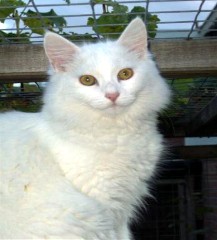
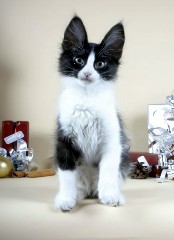
All-white Turkish Van Turkish Angora
3.2 Deafness in white cats
Another issue was the deafness occuring in all-white cats. Breeders of the all-white Turkish Van are well aware of this problem. To reduce the risks, it is recommended to mate all-white Turkish Vans to Van-patterned Turkish Vans (no white x white breedings). Only 100% hearing (BAER-test) all-white Turkish Vans are used for breeding.
4. Frequently Asked Questions (FAQ) & Genetics
As mentioned before, a minority of breeders is against recognition of the all-white Turkish Van for different reasons, often based on inaccurate or wrong information. For example:
The white Turkish Van is a product of matings between Turkish Van and
The white Turkish Van is a product of matings between Turkish Van and
Turkish Angora.
All white cats are deaf and by using white Turkish Vans for breeding, also patterned kittens will have hearing problems.
Breeding patterned to all white Turkish Vans will start producing offspring that are progressively less marked or more marked.
Breeders that do not want to work with all white cats, will suddenly have unwanted all white kittens in their litters, because all white Turkish Vans can be find in the pedigree.
As said, these reasons are often based on inaccurate genetic information. Therefor Dr. Leslie Lyons of the Feline Genome Project at UC Davis was contacted to give her expert opinion addressing the problems that would arise from patterned to white breedings.
4.1 Question:
Dominate white, Epistatic white and white masking gene are all the same thing. The cats that are in the Turkish Van breeding programs are homozygous piebald (SS) and homozygous piebald with dominate white (SSW).
Answer Dr. Lyons:
I have not heard these terms used before our discussion. Dominant white is epistatic to all other colors, meaning it overrides the other colors, hence, ��masks�� the other colors. So, I think these are all the same idea. Dominant white causes a cat to have few, if any, melanocytes, the cells that make pigment. If these cells are not present, then, no color can be produced, although the cats have all the other genes required to make color. Dominant white has two alleles (W,w). W causes no melanocytes. If a cats is WW, I am not sure what happens, they may not be viable, I never have seen data on this. It could be obtained from any breed with dominant white.
4.2 Question:
Dominate white will function in Turkish Vans as it functions in any other breed of cat. Dominate white is a dominate gene. If the gene is present in a cat, it will be expressed � the cat will be white. The only health risk associated with dominate white is the possibility of deafness.
Answer Dr. Lyons:
Correct.
4.3 Question:
The patterned offspring from a patterned to white breeding have no greater incidence of deafness than the general cat population.
Answer Dr. Lyons:
Correct. If the dominant white cat is Ww, then 50% of the offspring should have pattern. The risk of deafness would be the same as any other Van patterned cat. I have not heard of confirmation that Van patterned cats, even with blue eyes, have deafness.
I did ask European group about this as I thought they were collecting information, but, not sure if that ever happened.
4.4 Question:
If the cat is not white, it does not carry the masking gene. It cannot pass the marking gene or possibility of deafness to it�s offspring.
Answer Dr. Lyons:
Correct.
4.5 Question:
A Van patterned cat bred to a white Turkish Van will produce offspring that are either Van patterned or white (masking the Van pattern).
Answer Dr. Lyons:
Correct. BUT, we are assuming that dominant white and white spotting is acting as two different genes. This is not known for certain. However, I would bet that a homozygous dominant white (W,W) is not viable and perhaps dies in utero and we never produce these kittens.
4.6 Question:
Breeding patterned to white will not start producing offspring that are progressively less marked or more marked (to the point of solid colors other than white).
Answer Dr. Lyons:
I would think this has nothing to do with breeding to dominant white but the variation in the alleles one can have that produces bi-color. I do not think there is only one bicolour allele, S, in the world, and hence, when these alleles get mixed and matched, you get weird patterns. I think, for example, that Ragdolls may have various alleles at the white spotting gene.
4.7 Question:
The piebald gene is not predictable. The spotting associated with the spotting gene is random to a certain extent. Under marked and over marked cats, as well as ��perfectly�� marked cats, can all occur within the same litter. The dominate white gene will have no effect on the amount of spotting in a patterned cat, except to mask the pattern. Under the white, the cat will still be Van patterned.
Answer Dr. Lyons:
Correct, part of this variation is the randomness of cell migrations and the background genetics of the cat that interacts with the cell migration. Also, see above, there may be more than one bicolour allele and when mixed, may give unpredictable patterns.
4.8 Question:
While a ��grade 10�� piebald (solid white from 2 piebald parents) is genetically possible, that white cat would not produce solid white kittens with any degree of predictability.
Answer Dr. Lyons:
Correct.
4.9 Question:
A white cat that is dominate white will predictability produce an average of 50% white cats and 50% patterned cats when mated to a patterned cat.
Answer Dr. Lyons:
Correct, provided again, it is not WW, but, rather unlikely these exist.
4.10 Conclusion
Van-patterned kittens out of an all-white and a Van-patterned parent, will not have a higher risk for deafness than any other Van-patterned cat, nor will they have a higher risk for any other disease.
A Van-patterned Turkish Van, even if it has all-white ancestors on its pedigree, does not carry the dominate white gene, which means it can never have all-white offspring unless mated to an all-white Turkish Van. Anyone not wishing to work with all-white Turkish Vans should simply not acquire any.
Using all-white Turkish Vans for the Turkish Van breeding program, will not lead to an increase of under- or over marked Turkish Vans. The dominate white gene will have no effect on the amount of spotting in a patterned cat, except to mask the pattern.
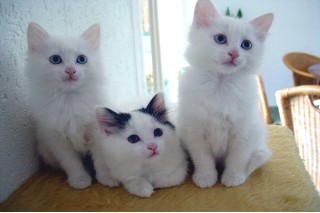
Van patterned and all-white Turkish Van kittens in 1 litter
Picture/breeder: Toin de Groot
5. Type
The all-white Turkish Van and the patterned Turkish Van should be indistinguishable as far as type is concerned, the only difference being the colored markings. Both cats belong to a semi-longhaired breed from the rugged region of the Middle East centred on Lake Van, where the climate varies to extremes.
It is a large, muscular cat; the strength and power is evident in substantial body and legs.
The breed does not gain full maturity until three years or more, therefore allowances must be made for age and gender. Individual cats should convey an impression of a well balanced, well proportioned and strong appearance in which no one feature is exaggerated.
Head: substantial broad wedge, nose medium to long, straight but with a barely perceptible dip in profile.
Ears: Moderately large, well feathered, fairly close together and set high on head.
Eyes: Large and oval, alert and expressive. To be of the requisite colour with pink rims.
Body: Long and sturdy, broad, muscular and deep-chested, especially the males.
Legs and Feet: Legs well-boned and medium in length. Feet neat well rounded and tufted.
Tail: Full brush, length to balance with the body.
Coat and Condition: Fur should be long, soft and silky to the roots. No woolly undercoat. It should be noted that the winter coat of the Turkish Van is longer and heavier than the summer coat. Longer coated cats are to be preferred. The neck and chest ruff should become more pronounced with age.
Color: chalk white coat. Ears should be a delicate shell pink inside. Nose leather and paw pads pink.
6. References
Cat World, A Feline Encyclopedia by Desmond Morris (1996)
De grote katten encyclopedie by J.J. Verhoef-Verhallen
Classic Turkish Van Cat Association, Vantasia
http://www.vantasia.org
Articles written by Sharon Walcott - cattery Aledo, US (2006)
Articles written by Melvin Walcott - cattery Aledo, US (2006)
Kedigen website, www.kedigen.com
Vankedisi net, www.vankedisi.net
Republic of Turkey, Ministry of Culture http://www.kultur.gov.tr/english/yeni/vankedisi.html
The all-white Turkish Van WCG � Dortmund, 30 March 2007
